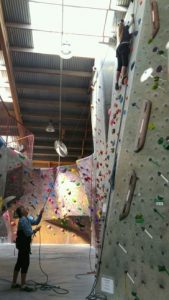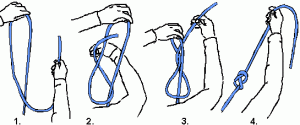 In Part 1 of this 3-part series, I offered a climbing analogy for leading yourself with your commitments, your “why’s”, and I promised to share the calls-and-responses between climber and belayer that exemplify support through accountability and how to translate them into team success. Read on! (That’s me in blue jacket, belaying niece Caity.)
In Part 1 of this 3-part series, I offered a climbing analogy for leading yourself with your commitments, your “why’s”, and I promised to share the calls-and-responses between climber and belayer that exemplify support through accountability and how to translate them into team success. Read on! (That’s me in blue jacket, belaying niece Caity.)
In the top-rope climbing class at Pacific Edge, I learned different climbing techniques and how to belay. Top-rope climbing is a style in which the climber is securely attached to a rope which then passes up, through an anchor system at the top of the climb, and down to a belayer at the foot of the climb. The belayer is the person on the ground who secures the climber for a safe ascent.
 A significant amount of instruction was dedicated to safety. In addition to tying proper knots, we learned and used essential communication call-and-responses between the climber and the belayer. Safety was the senior context of the conversation between climber and belayer; a secondary context was “make it to the top”.
A significant amount of instruction was dedicated to safety. In addition to tying proper knots, we learned and used essential communication call-and-responses between the climber and the belayer. Safety was the senior context of the conversation between climber and belayer; a secondary context was “make it to the top”.
Call & Response
In basic top-climbing, a few of the conversations between climber and belayer sound like this:
| Climber’s Call (Request to Belayer) | Belayer’s Response (to Climber’s Request) |
On Belay? |
Belay ON |
Climbing |
Climb ON |
Tension |
Tension ON |
The power of these exchanges: A climber doesn’t move until she hears the belayer’s response that says what action can be taken safely.
In the climbing class, this exchange can often be heard:
Student: Well, I can see if the belay is hooked up, I just did the safety check. You mean that even when I’m on the ground, standing next to the belayer, and before I start climbing, I say “belay on?
Instructor: Yes.
Student: Aren’t we over-doing this communication thing?
Instructor: No. The way you begin the climb sets the human connection for the climb.
So what do the belayer’s responses mean?
The belayer’s response of “Belay On” means: We are safely connected. I am here to keep you safe. To the climber’s “Climbing”, the belayer’s “Climb On” means: I’m ready for you to head toward your goal. To “Tension”, the Belayer’s response says: I’m holding your weight. You can rest, shake arms out, put your full weight in your harness, and release your grip. I’ve got you. (More about Tension in Part 3 of this series.)
It’s the same in a business (any) relationship – how you begin the relationship establishes a context and connection for what’s next. Let’s move from climbing to cubicle-ing.
Off the wall, into the cubicle
In a relationship where there is a commitment to a specific results or outcomes, a particular kind of call & response – called “conversations for action” – coordinates the action so both can fulfill their role successfully.
| Response to a Request | What your Response Means |
| Accept | I promise to do as you request, fulfilling the conditions you specified, by the Y time. (A promise is not a guarantee.) |
| Decline | I do not accept the request. (It isn’t a request if a person can’t decline. If a person can’t decline, then you are making a demand.) |
| Counter-offer | I accept the request with these proposed changes … Do you accept my counter offer? |
| Promise-to-promise | I promise to respond to your request by Y time. (Without a time specified, it is an intention, not a promise.) |
Sometimes people (in and outside of business) tell me, “Oh, I only make requests when it really matters, when it’s really important.” My response: So …. You do lots of work during the day that isn’t important enough to require coordination or certainty? Doesn’t matter when it gets done? Work in an environment that encourages micromanaging? Oh…
Practices creates trustworthiness
It’s the practice (practice: a behavior done regularly and with an intention to produce a particular result) of “being in communication” that coordinates the action, that builds the relationship, that supports the journey. It’s the practice of having conversations for action – and the follow through with appropriate behavior – that creates trust and trustworthiness and that makes new levels of results possible.
No matter what your virtual mountain is — on-boarding new hires, laying people off, launching a new product, leading a team or an entire organization — using a shared, meaningful “call & response” builds accountability and deepens trust – and both of those are essential to producing the kind of relationships that produce outstanding, extraordinary results.
In the final part in this series, I’ll reveal how the knots of accountability are essential for building trust and producing results especially when the “yogurt hits the fan.” (<– my favorite Tom Peters quote).
Climb on!
Subscribe
Get Camille's latest posts!
